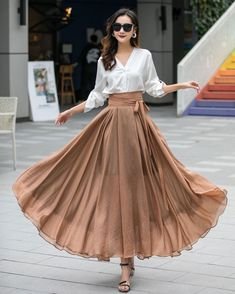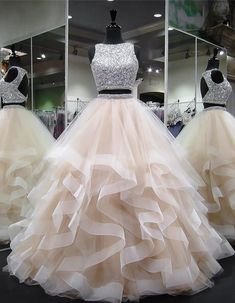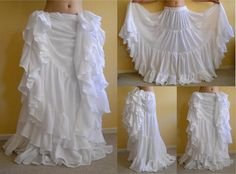Cancan Skirt
The can-can skirt is a vibrant and energetic garment known for its voluminous layers of ruffles or frills, often associated with dance performances and theatrical shows. Originating in French cabarets in the 19th century, the can-can skirt has evolved into a symbol of fun, movement, and flamboyance. In this class, we will explore the history, design elements, materials, construction techniques, and styling tips for creating can-can skirts. Whether you’re sewing for a dance performance, costume event, or simply for personal enjoyment, mastering the art of making can-can skirts will add excitement and creativity to your sewing repertoire.
1. Introduction to Can-Can Skirt
Overview:

- Purpose: The can-can skirt is designed to create dramatic movement and visual impact, ideal for dance performances and stage shows.
- Silhouette: Characterized by its multiple layers of ruffles or tiers that flare outwards, enhancing the dancer’s movements.
- Versatility: While traditionally associated with dance costumes, modern interpretations allow for casual or themed wear.
2. History and Evolution
A. Origins:
- The can-can dance originated in Parisian cabarets in the early 19th century, known for its lively and energetic choreography.
- The skirt’s design evolved to accommodate the high kicks and spirited movements of the dancers, emphasizing freedom and expression.
B. Cultural Influence:
- The can-can skirt became synonymous with French culture and cabaret performances, symbolizing exuberance and artistic expression.
- Over time, the skirt’s design has inspired fashion trends and costume designs beyond theatrical settings.
3. Design Elements
A. Silhouette
1. Ruffled Layers:
- The skirt features multiple layers of ruffles or tiers that add volume and movement.
- Layers are gathered or pleated at the waistband to create a full and flared silhouette.
B. Waistband
1. Fitted or Elastic Waistband:
- The waistband can be tailored with a fitted closure or elasticized for comfort and flexibility.
- It supports the weight of the skirt and secures it around the waist during movement.
C. Length
1. Mini to Midi Length:
- Can-can skirts are typically designed to fall above the knee or at midi length to enhance leg visibility and movement.
- Length variations depend on the intended use, from dance performances to casual wear.
D. Fabric and Embellishments
1. Fabric Choices:
- Tulle: Lightweight and sheer, commonly used for its ability to hold shape and create volume.
- Chiffon: Soft and flowing, adds a delicate touch to the skirt’s layers.
- Satin: Provides a smooth finish and adds a luxurious element to the skirt.
2. Embellishments:

- Sequins: Add sparkle and shine to the skirt, enhancing stage presence and visibility under lights.
- Ribbons or Bows: Decorative elements that add whimsy and charm to the skirt’s design.
- Lace or Trim: Used to accentuate ruffles or hemlines, adding texture and detail to the overall look.
4. Materials Needed
A. Fabric and Supplies
1. Tulle or Chiffon: Main fabrics for creating ruffled layers. 2. Satin or Cotton: For waistband and lining if necessary. 3. Elastic: For waistband if opting for an elasticized closure. 4. Thread: High-quality thread matching the fabric color. 5. Scissors, Pins, Measuring Tape: Basic sewing tools for cutting and measuring fabric. 6. Sewing Machine or Needle and Thread: Depending on whether you sew by hand or machine.
5. Pattern Drafting and Cutting
A. Using Commercial Patterns
1. Choosing a Pattern:
- Select a can-can skirt pattern available from sewing pattern companies, often found in costume or dancewear sections.
- Ensure the pattern includes instructions for multiple layers of ruffles and waistband options.
B. Drafting Your Own Pattern
1. Measurements:
- Take accurate measurements of waist circumference and desired skirt length.
- Calculate the width and length of each ruffle layer based on the desired fullness and number of tiers.
2. Drafting Steps:
- Draw a pattern for each ruffle layer on pattern paper, increasing the radius for each subsequent layer.
- Add seam allowances (typically ⅜ inch or 1 cm) to all edges for sewing.
- Cut out the pattern pieces for the ruffles and waistband.
6. Sewing Techniques
A. Ruffle Construction
1. Gathering Ruffles:
- Gather each ruffle layer along one edge using a long basting stitch or gathering foot on your sewing machine.
- Distribute gathers evenly to achieve a full and uniform appearance.
B. Attaching Ruffles
1. Layering Ruffles:
- Starting with the longest ruffle layer, attach each subsequent layer to the waistband, overlapping slightly to create volume.
- Pin or baste layers in place before sewing to ensure alignment and even distribution.

C. Waistband Assembly
1. Waistband Options:
- If using a fitted waistband, attach it to the top of the ruffle layers, ensuring it fits snugly around the waist.
- For an elastic waistband, measure and cut elastic to fit comfortably around the waist, then attach to the skirt top edge.
D. Hemming and Finishing
1. Hem Finish:
- Finish the bottom edge of the skirt with a narrow hem using a straight stitch or rolled hem technique.
- Press the hem to ensure a clean finish and maintain the shape of the ruffles.
7. Embellishments and Decorative Details
A. Adding Embellishments
1. Sequins or Beads:
- Sew sequins or beads onto the ruffle layers or waistband for added sparkle and visual interest.
- Choose colors and sizes that complement the fabric and enhance the overall design.
B. Ribbon or Lace Trim
1. Accentuating Ruffles:
- Attach ribbon or lace trim along the edges of ruffle layers to define and highlight each tier.
- Use contrasting or matching colors to create a cohesive look.
8. Styling Tips
A. Performance Wear
1. Dance Performances: Pair with a fitted leotard or bodysuit for freedom of movement and enhanced performance aesthetics.
- Stage Shows: Coordinate with themed accessories and footwear for a cohesive costume ensemble.
B. Casual or Costume Wear
1. Themed Events: Customize the skirt with themed fabrics and embellishments for costume parties or themed events.
- Festivals or Celebrations: Wear with a simple top and accessories for a playful and festive look.
C. Modern Interpretations
1. Everyday Wear: Style with a fitted top or blouse for a contemporary twist on the traditional can-can skirt.
- Layering: Experiment with layering techniques, such as wearing over leggings or tights for added warmth and dimension.
9. Care and Maintenance
A. Washing Instructions
1. Fabric Care: Follow specific care instructions provided for each fabric type used in the skirt.
- Hand Wash or Gentle Cycle: Use a delicate detergent and avoid harsh washing methods to preserve fabric quality and color.
B. Storage
1. Hanging: Hang skirts on padded hangers to maintain their shape and prevent creasing.
- Fold Carefully: Fold skirts neatly and store in a cool, dry place away from direct sunlight to prevent fading and damage.
10. Troubleshooting and Tips for Success
A. Fit Adjustments
1. Waistband Fit: Ensure the waistband fits comfortably and securely around the waist without being too tight or loose.
- Ruffle Alignment: Check ruffle layers for even distribution and adjust gathers as needed for a balanced silhouette.
B. Tips for Success

1. Practice Techniques: Experiment with gathering, attaching ruffles, and finishing techniques on scrap fabric before starting on the actual skirt.
- Precision: Take time to measure and cut pattern pieces accurately to achieve a professional-looking can-can skirt.
Conclusion
The can-can skirt embodies the spirit of fun, movement, and theatrical flair, making it a captivating addition to any wardrobe or costume collection. By understanding the history, design elements, materials, pattern drafting, sewing techniques, and styling options covered in this class, you can confidently create can-can skirts tailored to your unique preferences and creative vision. Whether sewing for dance performances, costume events, or personal enjoyment, mastering the art of making can-can skirts allows you to explore your creativity and sewing skills while embracing the vibrancy and energy associated with this iconic garment. Enjoy the process of designing and sewing can-can skirts that capture the essence of joy and movement, bringing excitement and personality to every wear.
